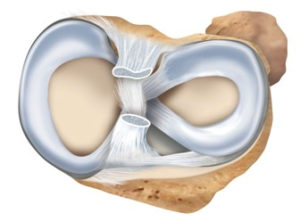Introduction
The meniscus is a half moon shaped piece of cartilage that lies between the weight bearing surfaces of the thigh bone (the femur) and the shin bone (the tibia). There are two of these in the normal knee. The inner one – the medial meniscus and the outer one is the lateral meniscus.
These work as shock absorbers in the knee reducing the impact on the gliding surface of the knee – the articular cartilage. The shape and structure of the meniscal cartilages allow the force of weight bearing such as in walking or running to be evenly distributed over a wide area of the knee. When the meniscus is not functioning then these forces are concentrated into a small area which can lead to early degeneration of the articular cartilage.
Meniscal Tears
The meniscus is a commonly injured structure in the knee. It can be torn at any age. In young people the meniscus is a strong and supple structure and injuries to it usually require a lot of force such as in sporting injuries. They are often associated with ligamentous injuries. As one ages the meniscus begins to degenerate as its blood supply is quite poor. It loses its tensile strength and tears can occur from relatively minor injuries.
Meniscal tears occur due to two different mechanisms. They can occur due to a sudden violent load to the meniscus which causes it to fail immediately or it can fail due to repetitive loading over time. Degenerative meniscal tears happen in this way. Sometimes a specific injury can not be recalled due to this repetitive loading cause.
Signs And Symptoms
The most common problem caused by a torn meniscus is pain. This can be felt along the joint line on the side of the meniscus or it can be poorly localised to the whole knee. The pain is mechanical in nature – any twisting, squatting or impacting activity that disturbs the tear causes pain. The pain may settle with rest but then flare again with resumption of activities. The knee may swell in response to the injured meniscus. This may fluctuate over time.
The knee can become locked if a flap of meniscus becomes jammed between the two weight bearing areas of the joint. The torn piece of meniscus can cause abnormal wear of the articular cartilage if left unchecked as it rubs on the gliding surfaces of the knee. This can lead to wear and tear arthritis.
Treatment
Initial treatment is aimed at reducing pain and swelling in the knee. Anti-inflammatory medications may be used. RICE – Rest, Ice, Compression and Elevation may settle the knee. However if the symptoms are not settling or it is felt that the tear is causing further damage with the knee then an Arthroscopic Surgery will be recommended. If the knee is locked so as to prevent full extension then Arthroscopic Surgery should be performed early
Surgery
Meniscal surgery is done using the arthroscope. Typically the torn area is removed as it has a poor blood supply and little chance of healing. The aim of surgery is to remove the torn area whilst leaving the rest of the meniscus that is stable and may still function. Sometimes the meniscus is de-functioned due to the tear.
The goal of surgery is to reduce the mechanical problem that the torn meniscus is creating, and to prevent further damage from the tear. Removing the torn meniscus may result in early onset arthritis due to loss of the menisci’s shock absorbing function. This risk is reduced by only removing that part of the meniscus which is no longer working.
Occasionally the meniscal tear can be repaired with sutures rather than being removed. Certain criteria need to be met for a repaired meniscus to heal. This is typically in the younger patient with a single traumatic injury to the meniscus with a good blood supply. The most common situation is when the tear accompanies a rupture to the Anterior Cruciate Ligament. The post-operative course is quite different for a meniscal repair, often with a prolonged period on crutches with a brace.
Download
